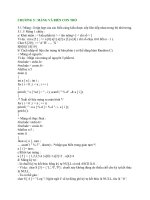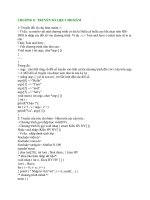Tài liệu C++ Lab2 Sending the output to a printfile Data Types pptx
Bạn đang xem bản rút gọn của tài liệu. Xem và tải ngay bản đầy đủ của tài liệu tại đây (52.37 KB, 6 trang )
Lab2
Sending the output to a printfile
Data Types
You are required to submit hard copies of all programs and program runs for
every assignment given to you. This lab explains how to send the output to a text file
which can be printed from any program (such as notepad) or directly from DOS.
Suppose you created a text file called carpet.txt from a program, this file then can
be printed by opening it under Word, WordPerfect, or any other program. You can also
print it by going to DOS prompt and typing the following: type carpet.txt > prn
Program OneA_1.
/********************************************************
Printing to a file
By Dr. John Abraham
Created for 1380 students
Instructional objective: create print file One_2.txt
********************************************************/
#include <iostream>
#include <fstream> //to handle files
using namespace std;
int main ()
{
int i,j,k,l, m,n;
float a,b,c;
ofstream outfile; //output file stream handle is outfile
outfile.open("a:One_2.txt"); //assign a DOS name to the handle
//creates a file called One_2.txt in floppy drive A:
//integer operations
cout << "INTEGER OPERATIONS\n \n";
i = 6 + 3;
l = 6.5;
m = 3.5;
j = l + m;
k = 10 /3;
n = 10 % 3;
cout << "6 + 3 = " << i << "\n";
cout << "l = 6.5, m = 3.5 >l + m = " << j << "\n";
cout << "10 / 3 = " << k << "\n";
cout << "10 % 3 = " << n << "\n";
outfile << "6 + 3 = " << i << "\n";
outfile << "l = 6.5, m = 3.5 >l + m = " << j << "\n";
outfile << "10 / 3 = " << k << "\n";
outfile << "10 % 3 = " << n << "\n";
//real and mixed operations
cout << "\nREAL AND MIXED OPERATIONS \n \n";
outfile << "\nREAL AND MIXED OPERATIONS \n \n";
a = 10 / 3;
b = 10.0 / 3.0;
c = 10.0 /3;
cout << "10 / 3 = " << a << "\n";
cout << "10.0 / 3.0 = " << b << "\n";
cout << "10.0 / 3 = " << c << "\n";
outfile << "10 / 3 = " << a << "\n";
outfile << "10.0 / 3.0 = " << b << "\n";
outfile << "10.0 / 3 = " << c << "\n";
outfile.close();
getchar();
return 0;
}
In order to create a textfile follow these steps:
1. Required preprocessor directive: #include <fstream>
2. Give a file handle such as outfile, printfile, textfile, or anything you like. Now
on the file will be referred to using this name in the program.
3. Assign this handle to an actual DOS file name. DOS file names are 8
character long, a dot, and 3 character extension. You may include the drive
letter and path in front of the file name. For example:
C:\mydocuments\cprograms\printfiles\carpet.txt
4. Place any character stream you want in this file by using the << flow director.
The easiest way to do this is to make copies of every cout lines in the program
and change the cout to the file handle name. See example Program OneA_1.
5. Close the file.
To print the textfile created by this program, follow these steps:
1. Open Notepad from StartÆProgramsÆAccessories
2. Open the file you created
3. From file option, choose print
You will be required to follow these steps for all program assignments now on.
Given below is another example of a program that sends output to a file. This program
calculates area and perimeter of a circle. In this program, I have placed all file related
code in one separate section.
***** Program: Calculate area and perimeter of a Circle
By: Dr. John Abraham
Prepared for my CSCI 1380 students
Assignment: number 2
Due Date: 1-25-05
Algorithm:
1. Get the radius of the circle
2. Calculate the perimeter using the equation
perimeter = 2 * radius * PI
3. Calculate the area using the equation
area = radius * radius * PI
4. Print out the perimeter and area
**************/
#include <iostream>
#include <fstream>
using namespace std;
int main()
{
/*** declarations ****/
const float PI = 3.14;
float radius, area, perimeter;
/**** Input ******/
cout << "Enter the radius of the circle in cm? " ;
cin >> radius;
/**** Process *****/
area = PI * radius * radius;
perimeter = 2 * PI * radius;
/**** output to screen *****/
cout <<endl << "The area of the circle is: " << area << "cm²"
<<endl;
cout <<"The perimeter of the circle is: " <<perimeter << "cm"
<<endl;
/*** output to file *****/
//This output includes data input section as well
ofstream outfile; //output file stream handle is outfile
outfile.open("a:circle.txt"); /* assign a DOS name to the handle.
creates a file called
circle.txt in floppy drive A: */
outfile << "Enter the radius of the circle in cm? " << radius;
outfile <<endl << "The area of the circle is: " << area << "cm²"
<<endl;
outfile <<"The perimeter of the circle is: " <<perimeter << "cm"
<<endl;
outfile.close(); //close the file
return 0;
}
And here is the output.
C++ Data Types
There are simple data types such as integer, float, double, char, Bool etc. that can only hold one
value at a time. Compound data types can have multiple values such as grades from a test. We
will be studying compound data types and user defined data types later. Declaring data types
enables the compiler to set aside necessary amount of memory storage. For example, short
integer takes 2 bytes of storage and holds any numbers between -32,768 and +32,767 inclusive.
If you define a data type as int the compiler will set aside by word of memory (word varies on
different machines). A 32 bit machine will set aside 4 bytes for an int that can hold any value
from -2,147,483,648 to +2,147,483,647.
A char data type can hold one character and it requires one byte. If you need store a name of a
customer in the memory you have to declare an array of characters or use an object of the C++
string class. In order to use the string class you need to add #include <string> as a
preprocessor directive.
There are three data types than can be used for floating point numbers: float, and double. Float
requires 4 bytes and the double 8 bytes. The more bytes used the better the precision of the
number.
Since the amount of memory set aside is different on different machines, C++ provides for a
way to find the amount of memory set aside: sizeof(int) will give you amount of memory saved
for an int. You can substitute the data type used inside the parenthesis.
Before manipulating a variable, you must assign a value to it. You can assign a value at the
time you declare a variable – we call this initializing a variable. Or you can read a value from
a file or the keyboard.
Homework:
Write a program to find the average of three grades for a student. Display the name of the
student and the average of these three grades. Learn to use the String Class.









